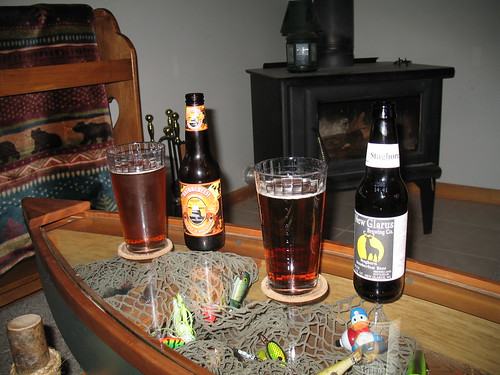On the subjectivity of beer evaluation
A while back I had an online discussion with a BeerAdvocate member about homebrew competitions. I was arguing that the evaluations in homebrew competitions are largely arbitrary. Don't get me wrong... I think a beer that clearly falls outside of the style guidelines will never win. However, assuming it falls within the basic guidelines (and I would guess most beers entered in competitions do), I believe the difference between a winning and non-winning beer is too subjective to be repeatable from one competition to the next. He (a BJCP certified judge, I should add) disagreed and argued that the same beers would indeed rise to the top regardless of who the judges are.
Exhibit A in my argument that beer judging is largely arbitrary? Offhand I can recall four beers we've brewed that have won ribbons at homebrew competitions: our Gose which somehow won a best of show, our Sticke Altbier and Schwarzbier, both of which took first place awards, and our premium American lager which won a second-place ribbon. Each of those beers was entered in at least one other competition. None of them won a second ribbon (and with at least two of those beers the ribbon was won in a competition with a larger number of entries, so it's not just a matter of winning smaller, easier competitions).
Exhibit B? I recently entered our Altbier in the CBS Spooky Brew Review. While they still haven't posted results a month later (not cool, by the way), somebody posted unofficial results and assuming he's not full of crap our Altbier didn't win anything. The funny thing is I think it's the best beer we've ever brewed, both in terms of fitting the style guidelines and in terms of overall quality. Yet it didn't even finish in the top three out of six measly beers. Now I haven't gotten the score sheets back, so it's possible a bottle got infected or oxidized. But assuming the judges tasted the same beer I've been drinking, I can only conclude that our tastes are different. And that's not a knock on the judges; that's just the nature of subjectivity.
Now, fast-forward to this past Saturday and our annual Novemberfest party for Exhibit C. We served my beloved Altbier, our tried-and-true Hefeweizen, and an Oktoberfest beer that finished fermentation at WAY too high of a temperature, leaving it with a fairly pronounced clove phenolic. I seriously contemplated not serving it, that's how bad I thought it was. Well, only one keg got tapped at our party and guess which one it was? You guessed it, the Oktoberfest. I had one neighbor insist it was the best beer she'd ever had. Now obviously this is a different situation than a BJCP-certified competition, but still, I couldn't help but be struck by the irony that the beer I almost dumped down the drain was the most popular with my friends.
Anyway, is there a point to this? I'm not sure. So I'm going to cop out and end with a Simpsons quote:
Exhibit A in my argument that beer judging is largely arbitrary? Offhand I can recall four beers we've brewed that have won ribbons at homebrew competitions: our Gose which somehow won a best of show, our Sticke Altbier and Schwarzbier, both of which took first place awards, and our premium American lager which won a second-place ribbon. Each of those beers was entered in at least one other competition. None of them won a second ribbon (and with at least two of those beers the ribbon was won in a competition with a larger number of entries, so it's not just a matter of winning smaller, easier competitions).
Exhibit B? I recently entered our Altbier in the CBS Spooky Brew Review. While they still haven't posted results a month later (not cool, by the way), somebody posted unofficial results and assuming he's not full of crap our Altbier didn't win anything. The funny thing is I think it's the best beer we've ever brewed, both in terms of fitting the style guidelines and in terms of overall quality. Yet it didn't even finish in the top three out of six measly beers. Now I haven't gotten the score sheets back, so it's possible a bottle got infected or oxidized. But assuming the judges tasted the same beer I've been drinking, I can only conclude that our tastes are different. And that's not a knock on the judges; that's just the nature of subjectivity.
Now, fast-forward to this past Saturday and our annual Novemberfest party for Exhibit C. We served my beloved Altbier, our tried-and-true Hefeweizen, and an Oktoberfest beer that finished fermentation at WAY too high of a temperature, leaving it with a fairly pronounced clove phenolic. I seriously contemplated not serving it, that's how bad I thought it was. Well, only one keg got tapped at our party and guess which one it was? You guessed it, the Oktoberfest. I had one neighbor insist it was the best beer she'd ever had. Now obviously this is a different situation than a BJCP-certified competition, but still, I couldn't help but be struck by the irony that the beer I almost dumped down the drain was the most popular with my friends.
Anyway, is there a point to this? I'm not sure. So I'm going to cop out and end with a Simpsons quote:
- Lisa: Perhaps there is no moral to this story.
- Homer: Exactly! It's just a bunch of stuff that happened.
- Marge: But it certainly was a memorable few days.
- Homer: Amen to that!
- [The family laughs]










